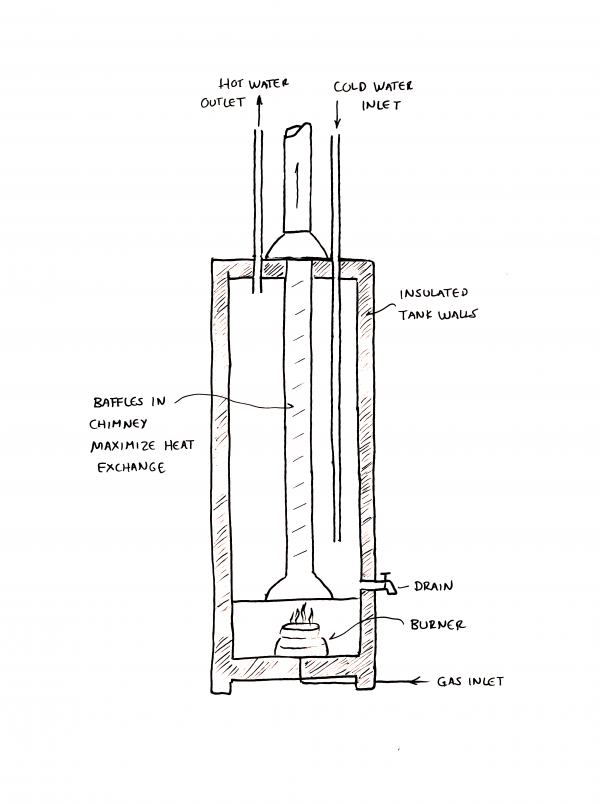Tank or Batch Heaters
HVAC: MATERIALS ENCYCLOPEDIA
Heat production & delivery
Biomass heat production (pellet-fired)
Fossil fuel heat production (gas- and oil-fired)
Biofuel heat production (biodiesel- and vegetable oil-fired)
Electric resistance heat production
Hydronic heat delivery (can supply an air delivery system)
Can be used for domestic hot water heating
System components
Metal or glass-lined metal tank with required inlet and outlet ports
Tank insulation
Integrated heat exchanger(s) if required
Direct vent (sealed) intake and exhaust (for combustion units)
Pressure and temperature relief valve, pumps, expansion tank and balance of system as required
Controls as required
How the system works
 A tank of the desired size (75–1100 liters / 20–300 gallons is common for residential purposes) holds water, which is heated from inside the tank. Combustion-fired units have a burner and exhaust inside the tank, and heat is absorbed into the water through contact with the chimney. Electric units have resistance heating elements inside the tank. Water is raised to and maintained at the desired temperature, and drawn from the tank as use requires.
A tank of the desired size (75–1100 liters / 20–300 gallons is common for residential purposes) holds water, which is heated from inside the tank. Combustion-fired units have a burner and exhaust inside the tank, and heat is absorbed into the water through contact with the chimney. Electric units have resistance heating elements inside the tank. Water is raised to and maintained at the desired temperature, and drawn from the tank as use requires.
Some units have integrated heat exchanger(s) to allow for combined use of space heating and domestic hot water and/or combining the tank with solar hydronic input.
System output
Residential water heater tanks have outputs that range from 10,000–200,000 Btu/hr, depending on their volume capacity and type of burner or electric element. Efficiency rates for combustion boilers range from 90–98 percent. Electric units are 100-percent efficient.
Environmental impacts: high
The impacts for water heater tanks are directly linked to the fuel source used to generate the heat. When considering the impacts of a fuel source, it is important to be as thorough as possible. Calculations for impacts must consider the entire life cycle, from extraction to processing, transportation, combustion and by-products. Effects on habitat, social fabric, geopolitical and financial systems and resilience must be taken into account along with more easily quantifiable (though likely controversial) numerical assessments such as carbon contributions and air pollutants.
Material costs: low
Labor input: low
Tank batch heaters are simple to install.
Skill level required for the homeowner
Installation — Easy.
Use — Easy.
Maintenance — Easy. Annual flushing will help prevent build up of sediment.
Sourcing/availability: Easy
Competitive quotes will be available in all regions.
Code compliance
Hot water tanks are an accepted solution in all building codes. It is not common to use a hot water tank as the main heat supply for a home, but if the Btu output matches the heat loss calculation it will be acceptable.
Durability: moderate to high
Tanks are very durable, and elements and burners can be replaced without changing the whole tank. Sedimentation and scaling are the biggest issues, but can be addressed with regular maintenance. Glass-lined tanks will not corrode, but metal tanks will eventually corrode over decades.
Indoor air quality
Any combustion device can create IAQ issues, as they consume air and produce exhaust. Modern, code-approved devices have “sealed” combustion, meaning that combustion air is drawn directly from outside and exhausted back to the outside, and usually drawn by a fan to ensure proper flow. There are many possible points of leakage in these systems; be sure to check installations for issues. The combustion chamber is never completely sealed from indoors, and some amount of indoor air will be drawn into the unit.
Hydronic delivery systems result in gentle air movement and minimal circulation of dust and allergens.
Forced-air delivery systems can circulate a lot of dust and allergens. Use the best filters possible to help reduce issues.
Adequate ventilation is required in any well-sealed home. Whether provided actively or passively, ensure that pre-warmed fresh air is introduced and circulated in the home during seasons when windows are closed.
Future development
The hot water tank is a simple device that has not changed much in the past decade, and is unlikely to develop in the future. More and better insulation is starting to be used on tanks, and improvements in this area would help reduce heat loss.
Resilience
Hot water tanks can function in some low-energy scenarios. The tanks are simple to adapt to homemade solar hydronic collectors.
Tips for a successful tank or batch heater
1. Heat loss is the largest drawback for water tanks. Choose a tank with the best possible insulation value, and consider adding extra insulation to the tank once it is installed.
2. Position the tank in a conditioned space to prevent heat losses that will occur in colder, unconditioned parts of the home.



